#Illinois tenant lawyer
Explore tagged Tumblr posts
Text

If you want to know who makes decisions in probate, Contact our experienced Probate attorney in Chicago IL at 872-252-7949.
#landlord tenant attorney Illinois#landlord-tenant dispute lawyer in Illinois#Illinois tenant lawyer#child abuse lawyer in Illinois#child custody attorney Illinois#child support lawyer Illinois#real estate eviction lawyer
0 notes
Text
[“Many landlords were part-timers: machinists or preachers or police officers who came to own property almost by accident (through inheritance, say) and saw real estate as a side gig. But the last forty years had witnessed the professionalization of property management. Since 1970, the number of people primarily employed as property managers had more than quadrupled. As more landlords began buying more property and thinking of themselves primarily as landlords (instead of people who happened to own the unit downstairs), professional associations proliferated, and with them support services, accreditations, training materials, and financial instruments. According to the Library of Congress, only three books offering apartment-management advice were published between 1951 and 1975. Between 1976 and 2014, the number rose to 215. Even if most landlords in a given city did not consider themselves “professionals,” housing had become a business.
The evening’s speaker was Ken Shields, from the Self Storage Brokers of America. After selling his insurance company, Shields had begun looking for a way to get into real estate. He started out with rooming houses, which meant he started out renting mainly to poor single men. “Very nice cash flow. But I no longer have them.” The room chuckled. “I made some good money, and I mean, I love to get money, but I’m still just as happy not running around and dealing with some of these dregs of society who live in rooming houses.”Sherrena, who owned a couple of rooming houses, laughed along with the room. Then Shields found self-storage. “It’s got the residual incomes of an apartment building, but,” he lowered his voice, squinted, “you don’t have the people. You just got their stuff!…This is the sweetest spot in the whole American economy. A receptacle for an enormous cascade of money.”
The landlords loved Ken Shields, even if he did live in Illinois. When he finished his speech, the room broke into applause. The RING president, a mustached man with a full pouch for a stomach, stood up clapping. When there wasn’t a speaker, he often organized round robins. One such evening, a woman from Lead and Asbestos Information Center, Inc., had started off by announcing, “There is money to be made on lead,” to a room of landlords who more often lost money trying to abate it. One landlord asked whether he would have to report the presence of asbestos to the city or the tenants if he tested for it. “No, you don’t,” the woman had said.
The conversation moved on and someone else had asked about garnishing wages. A lawyer informed the room that a landlord was allowed to garnish a tenant’s bank account and up to 20 percent of his or her income, but the last $1,000 was exempt. And welfare recipients were off-limits.
“How about intercepting their tax refund?” Sherrena had asked.
The lawyer looked a bit stunned. “Noooo, only the government can do that.”
Sherrena already knew that. She had looked into it before. Her question wasn’t a question; it was a message to Eric, Mark, Kathy, and everyone else in the room that she would do almost anything to get the rent. Many white landlords knew money could be made in the inner city, where property was cheap, but the thought of collecting payments on the North Side, let alone passing out eviction notices, made them nervous. Sherrena wanted them to know that she could help.”]
matthew desmond, from evicted: poverty and profit in the american city, 2016
145 notes
·
View notes
Text
A 6 year-old KID stabbed *26 times* to death in Illionis for being Palestanian .................. thanks to CNN!!!!
The authorities in suburban Chicago accused a man of fatally stabbing a 6-year-old boy on Saturday and seriously wounding the boy’s mother because they were Muslim, an attack that officials tied to the violence in Israel and Gaza.
The killing in Illinois alarmed Muslim leaders, who called on American politicians and journalists to more fully reflect the humanity of Palestinian people as they address the conflict overseas.
“This was directly connected to dehumanizing of Palestinians,” said Abdelnasser Rashid, a Democratic Illinois state representative who is Palestinian American.
Investigators in Will County, Ill., southwest of Chicago, described a gory scene. They said a 71-year-old landlord turned on the boy and his mother, who were his tenants, at their home in Plainfield Township on Saturday morning, stabbing them repeatedly with a serrated knife that had a seven-inch blade.
ADVERTISEMENT
SKIP ADVERTISEMENT

The boy, identified as Wadea Al-Fayoume by a family member and the Council on American-Islamic Relations, was stabbed 26 times and pronounced dead at a hospital, according to the sheriff’s office. The boy’s mother, 32, was in serious condition with more than a dozen stab wounds, officials said. Officials said she ran into a bathroom and continued fighting off the attacker as she dialed 911. Relatives said the family is Palestinian American.
The Will County Sheriff’s Office said in a statement on Sunday that “detectives were able to determine that both victims in this brutal attack were targeted by the suspect due to them being Muslim and the ongoing Middle Eastern conflict involving Hamas and the Israelis.” The statement did not specify how investigators knew the motive, but said they had conducted interviews and reviewed other evidence.
The man accused in the attack, Joseph M. Czuba, 71, was being held on charges of first-degree murder, attempted first-degree murder, two counts of a hate crime and aggravated battery with a deadly weapon.
Mr. Czuba was scheduled to make an initial court appearance in Will County on Monday, according to online records. It was not clear whether he had hired a lawyer.
7 notes
·
View notes
Text
Aaron Krolik Law Office works with tenants and landlords every step of the way to make sure they understand and are comfortable with the process. We are dedicated to providing results for our clients in Chicago and Cook County, Illinois. Tenant's rights in Chicago are protected by the Residential Landlord and Tenant Ordinance (RLTO).
0 notes
Photo



Rent Repayment Plan App for iPhone, iPad, and Mac now available. Tenants and landlords may use these documents for unpaid rent and avoid eviction. Visit www.byczek.pro/repayment.html for details and download.
#rent#apartment#tenant#landlord#attorney#law#legal#lawyer#app#apple#mac#iphone#ipad#eviction#housing#chicago#illinois#contract
0 notes
Photo

Edith Spurlock Sampson (October 13, 1898 – October 8, 1979) was an American lawyer and judge, and the first Black US delegate appointed to the United Nations on 24 August 1950. She conceded that Black people did not have equal rights in America but she said: "I would rather be a Negro in America than a citizen in any other land". In 1924, Sampson opened a law office on the South Side of Chicago, serving the local black community. From 1925 through 1942, she was associated with the Juvenile Court of Cook County and served as a probation officer. In 1927 Sampson became the first woman to earn a Master of Laws from Loyola University's Graduate Law School. She also passed the Illinois State Bar exam that year. In 1934 Sampson was admitted to practice before the Supreme Court. In 1943, she became one of the first black members of the National Association of Women Lawyers. In 1947 she was appointed an Assistant State's Attorney in Cook County. In 1962, Sampson ran for associate judge of the Municipal Court of Chicago, and easily won the election; she was the first black woman to be elected as a judge in the state of Illinois. In 1966, she became an associate judge for the Circuit Court of Cook County. Most of the cases that she heard were housing disputes involving poor tenants, in which she was perceived as "an understanding but tough grandmother". #africanhistory365 #africanexcellence #zetaphibeta (at Western Branch North, Chesapeake, Virginia) https://www.instagram.com/p/B3jyewOHXHy-rlZsFn0vEekaXaZUlDYSTMaKBA0/?igshid=1scdjfwct409k
2 notes
·
View notes
Text
How Attorneys Help Business Owners
In Illinois, business owners face obstacles every day that could lead to legal complications. When owners become confused, they turn to attorneys for answers. The attorneys are familiar with local business laws and help company owners. Owners who want to know more about what a business lawyer can do for them are encouraged to review the laws now.
Establishing Contracts for Business
The attorney helps the business owner establish legally binding contracts with other businesses and partners. The contracts present terms that are fair for all parties. the terms are well-defined and prevent possible misunderstandings. The contracts prevent either party from failing to fulfill their obligations.
Selling a Commercial Property
Lawyers help businesses sell their commercial property to buyers and investors. The process requires a sales contract and closing processes. The attorneys create terms that enforce payments and outline repercussions that occur if the buyer doesn't complete the transaction. The process involves an official appraisal for the property that ensures the buyer they are getting the property at a fair price. To learn more about selling properties, see available legal services now.

Creating Subleases for Other Businesses
Subleasing rental properties to other businesses eliminates additional obligations for the company. The new tenant pays a deposit to the original lessee and takes over the existing lease. All financial obligations are transferred to the new tenant and prevent any further costs. The terms of the sublease prevent the new tenant from failing to pay the rent without financial repercussions.
Mitigating Risks and Lawsuits
Attorneys review legal claims against the business owner. They mitigate risks whenever possible and determine the most suitable action. Businesses purchase liability coverage to pay for financial losses due to lawsuits. The attorney provides advice for all businesses when going to court. To review more mitigation options, get more information at ShakfehLaw.com right now.
Mediation and Settlement Offers
Mediation is often helpful when lawsuits are filed. The process allows both parties to discuss their grievances. When possible, the attorney presents a settlement offer to the claimant and keeps the case out of court. The mediation process is helpful for companies that provide specialty services, such as healthcare.
In Illinois, business owners enter into contracts with businesses and partners. The contracts explain the expectations of both parties. The legal documents are needed for selling commercial properties and when offering subleases. Business owners who need more answers now can find small business lawyers right now.
1 note
·
View note
Text
HOW COLD IS IT?
HOW COLD IS IT? An annotated thermometer
Fahrenheit / Celsius
+50 / +10 * New York tenants turn on the heat * Minnesotans plant gardens
+40 / +4 * Californians shiver uncontrollably * Minnesotans sunbathe
+35 / +2 * Italian cars don't start
+32 / 0 * Distilled water freezes
+30 / -1 * You can see your breath * You plan a vacation in Florida * Politicians begin to worry about the homeless * Minnesotans eat ice cream
+25 / -4 * Boston water freezes * Californians weep pitiably * Cat insists on sleeping on your bed with you
+20 / -7 * Cleveland water freezes * San Franciscans start thinking favorably of LA * Green Bay Packers fans put on T-shirts
+15 / -10 * You plan a vacation in Acapulco * Cat insists on sleeping in your bed with you * Minnesotans go swimming
+10 / -12 * Politicians begin to talk about the homeless * Too cold to snow * You need jumper cables to get the car going
0 / -18 * New York landlords turn on the heat * Sheboygan brats grilled on the patio, yum!
-5 / -21 * You can hear your breath * You plan a vacation in Hawaii
-10 / -23 * American cars don't start * Too cold to skate
-15 / -26 * You can cut your breath and use it to build an igloo * Miamians cease to exist * Minnesotans lick flagpoles
-20 / -29 * Cat insists on sleeping in your pajamas with you * Politicians actually do something about the homeless * People in LaCrosse think about taking down screens
-25 / -32 * Too cold to kiss * You need jumper cables to get the driver going * Japanese cars don't start * Milwaukee Brewers head for spring training
-30 / -34 * You plan a two-week hot bath * Pilsener freezes * Bock beer production begins * Minnesotans shovel snow off roof
-38 / -39 * Mercury freezes * Too cold to think * Minnesotans button top button
-40 / -40 * Californians disappear * Car insists on sleeping in your bed with you * Minnesotans put on sweaters
-50 / -46 * Congressional hot air freezes * Alaskans close the bathroom window * Green Bay Packers practice indoors
-60 / -51 * Walruses abandon Aleutians * Sign on Mount St. Helens: "Closed for the Season" * Minnesotans put gloves away, take out mittens * Boy Scouts in Eau Claire start Klondike Derby
-70 / -57 * Glaciers in Central Park * Hudson residents replace diving boards with hockey nets * Green Bay snowmobilers organize trans-lake race to Sault Ste. Marie
-80 / -62 * Polar bears abandon Baffin Island * Rhinelander Birkebeiner * Girl Scouts in Eau Claire start Klondike Derby
-90 / -68 * Edge of Antarctica reaches Rio de Janeiro * Lawyers chase ambulances for no more than 10 miles * Wisconsinites migrate to Minnesota thinking it MUST be warmer
-100 / -73 * Santa Claus abandons North Pole * Minnesotans pull down earflaps
-173 / -114 * Ethyl alcohol freezes * Only Door County cherries usable in brandy Manhattans
-297 / -183 * Oxygen precipitates out of atmosphere * Microbial life survives only on dairy products
-445 / -265 * Superconductivity
-452 / -269 * Helium becomes a liquid
-454 / -270 * Hell freezes over
-456 / -271 * Illinois drivers drop below 85 MPH on I-90
-458 / -272 * Incumbent politician renounces a campaign contribution
-460 / -273 (Absolute Zero) * All atomic motion ceases * Minnesotans allow as to how it's getting a mite nippy
Page Author:
Rob Rubin
Email:
Last Updated:
Friday, March 22, 1996
(C) 1996 Panther Free Press, All Rights Reserved
2 notes
·
View notes
Text
‘Keep it in writing’ – Suggestions from landlord-tenant lawyer Nicholas Bailey | WGN Radio 720
‘Keep it in writing’ – Suggestions from landlord-tenant lawyer Nicholas Bailey | WGN Radio 720
The program “Let’s Get Legal” that airs on WGN(AM) on Saturdays from 3 p.m. to 5 p.m. is sponsored by Illinois State Bar Association, Wochner Law Firm LLC, Camden Law Office, LLC, The Stogsdill Law Firm, P.C., Maurides Law, Miller & McGing Law, Anna K Law, The Devine Law Group, and Gordon Law Group. Click here for more information about our sponsors. Source link

View On WordPress
0 notes
Text
Looking Around: Horizontal Space
If there is one truth about the second half of the 20th Century it is that, by all accounts, we started moving out rather than up; horizontal rather than vertical. Not only through the process of suburbanization, the building of massive highways, and the rapid capital flight from cities, but also in how we designed everything from our homes to our workplaces.
It could be said that, since the development of major highways, America has flattened -- much in the same way that the invention of both the elevator and air conditioning brought skyscrapers to every major city in the first half of the 20th century.

I-55 Under Construction, 1972. Public Domain.
In his 1984 book Discovering the Vernacular Landscape, John Brinckerhoff Jackson observes this transition:
“Who has not noticed...that in almost every American town the upper stories of the buildings flanking Main Street are being deserted?...Despite all the activity on the street floor, the second and third and fourth floors of the older brick buildings are no longer in demand. Not many years ago, they accomodated the offices of lawyers and dentists and doctors; dance studios and certified public accountants. Now the gold lettering has vanished from the windows, and even the street door leading to the stairs is blocked. Sooner or later, the buildings themselves will be torn down, to be replaced by one-story buildings or parking lots.” (68)
Jackson attributes this decline in vertical spaces to technological changes. Sprawling manufacturing plants with mile long assembly lines make more sense logistically than having workflow between stories. “An efficiently planned office,” he notes “is now seen as a system of information flow, most flexible, most effective when horizontal.” Even new skyscrapers are less like the ones from the recent past, described as “... a stack of large, uninterrupted horizontal spaces: vastly improved construction methods have made this spaciousness possible.” (69)
The technology of the car has created for us a new way of perceiving the environment around us. Jackson cites “increased mobility, and even more, an experience of uninterrupted speed...bring with them a sharpened awareness of horizontal space.” (70) Vertical space can’t be seen as easily from the car, the de facto way of getting around in America.
Residential Horizontalization
This transformation began with the Federal Housing Act of 1934, which established the Federal Housing Administration. The FHA originally provided home loans to qualifying (read: white) families during the Great Depression, as part of the New Deal, in an attempt to stabilize the mortgage market.
The FHA came to the forefront after WWII, when the Housing Act of 1949 began to systematically dismantle cities while simultaneously setting the guidelines of suburban sprawl. The Housing Act of 1949 worked in three parts:
1.) Federal financing for slum clearance (often coupled with highway building) 2.) Promised 800,000 units of public housing (the act actually destroyed more units of housing than it built) 3.) Increased financing for rural home loans and gave the FHA more authority to issue mortgages.
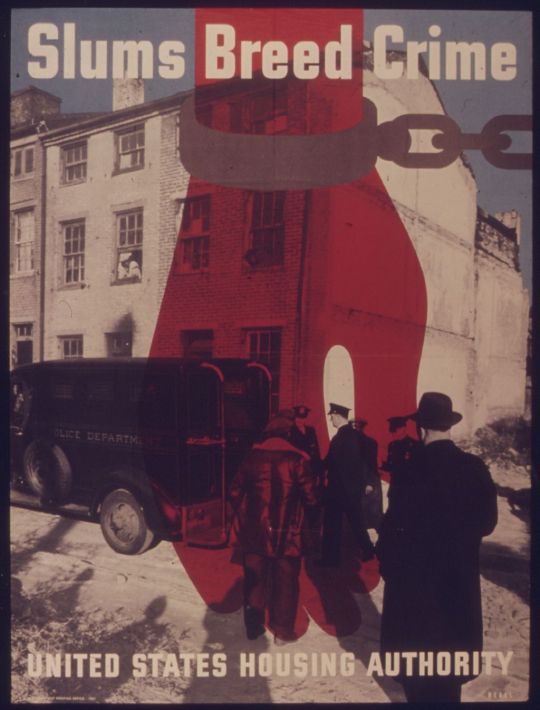
Poster from the 1940s.
This act had a devastating effect on cities. Not only did slum clearance destroy entire neighborhoods (often drawn along racial lines) and frequently replace them with highways (out to the suburbs!!), the process of Redlining (outlining areas deemed “high risk” and not worth issuing mortgages in, often in the inner city, almost always racially based) and the high preference for FHA-planned suburban communities over urban areas all but guaranteed a fully subsidized white flight from the cities.
What little public housing was built quickly fell into decline, as maintenance costs were tied to tenant rents - this, coupled with resistance to forced integration after Brown v Board of Education (1954) from whites led to their rapid depopulation of public housing. As a result, the remaining tenants could not offset the costs of empty units. This, coupled with a high youth density (unsupervised youths were often the cause of many maintenance problems - even benign ones, like breaking the elevators playing games of ‘elevator tag’), meant that existing public housing was quickly deteriorating. It was this combination of socioeconomic circumstances that led to the decline, and ultimately, the failure of the infamous Pruitt-Igoe housing complex in St. Louis, Missouri.
[For those of you who are interested in the policies and history of public housing, I recommend the books Public Housing Myths, and In Defense of Housing.]
The FHA and Suburb Planning
The FHA’s guidelines for issuing mortgages after the 1949 Housing Act centered around wide lots with driveways on streets organized to deter traffic, which had become a huge problem now that everyone had a car.
These wandering neighborhoods were often attached to arterial roads, but built with few entrances to these busy thoroughfares. Zoning was a huge part of why the curvilinear streets and island-like neighborhoods developed: the FHA was more likely to sponsor home loans to those looking to purchase a home in single-family residential zoned areas as part of its goal to protect lots from “adjacent non-conforming uses.”

However, it wasn’t always this way. In the earlier post-war suburbs, the FHA suggested subdivisions that were close to school, churches, the occasional commercial unit, and parks. What changed this was the 1956 Federal-Aid Highway Act, better known as the National Interstate and Defense Highways Act, which subsidized the construction of over a million miles of local and interstate highways. After these roads expanded exponentially, planning for less traffic meant sprawling deep into the countryside and the beginning of entirely new horizontal landscapes.
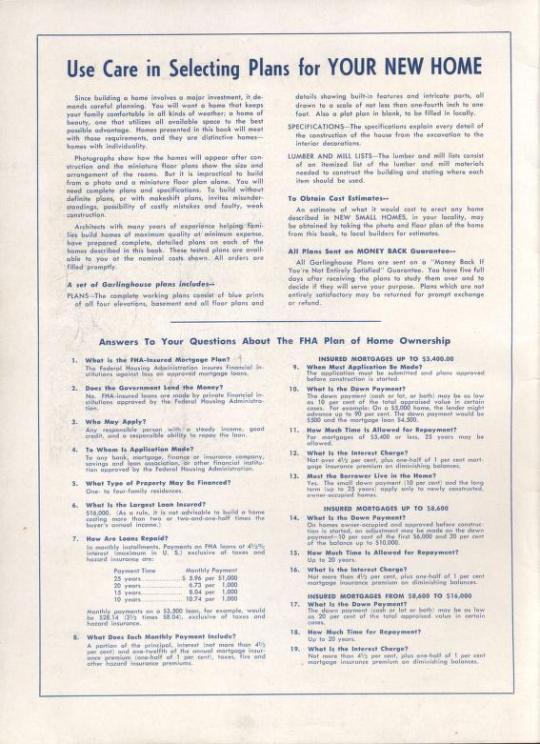
Garlinghouse Home Catalog insert from c. 1950
These policies imitated themselves in the architecture of common houses. The little post-war (white) working and middle-class Minimal Traditional house extended itself into the Ranch and Split-Level forms as lots grew larger and neighborhoods less dense. It was at this point that attached garages became ubiquitous, as car use had become increasingly necessary, cushioned by the increased lot size of the late 50s and beyond.

Catalog from 1958. Via Archive.org
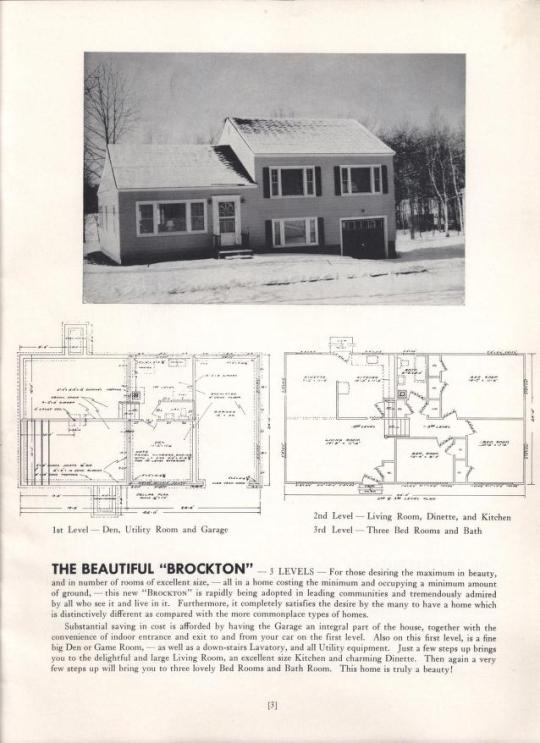
Northern Homes Catalog, c. Mid 60s. Public Domain.
For those who are curious, the origin of the McMansion lies in the Styled Ranches first popular in the 1930s in Hollywood and in more wealthier areas in the 1950s-1970s - these houses began the process of taking a basic built form (a Ranch) and applying various cladding materials and stylistic details to make it seem more elegant. For one-story McMansions, these houses are their predecessors.

Styled Ranch (note the pitch of the roof) from the 1970s
The Split-Level ensured that two-story homes became hot commodities amongst middle class homeowners. By the early 1980s, (after the end of the Energy Crisis) homeowners rejected the low ceiling height of the ranches and split-levels, and, coupled with less expensive building materials and riskier mortgages, the McMansion had arrived. Their massiveness of scale was, perhaps, the only verticalization that occurred during this time.
Commercial Horizontalization
The depletion of urban density was not just a matter of people moving to little boxes on winding streets. Business moved as well. Factories, once located in dense urban settings, moved to the suburbs, where massive horizontal plants were created to streamline the work process. After all, the assembly line works horizontally.
If you’ve ever traveled outside of Chicago, you pass through the exurb of Naperville. While also being a verifiable McMansion Hell (perhaps no group of people own more McMansions than the managerial class), the I-88 corridor from Naperville to Aurora offers one of the most spectacular arrays of office parks in existence. Uncommonly more than five floors and rarely more than ten, these monoliths languidly straddle the flat prairie landscape, neatly bundled up by ribbons of highway.

Helmut Jahn’s interesting “N” Building off of I-88, Naperville, Illinois.
After WWII, corporations began a new way of organizing their businesses in order to adapt to new means of national and later international expansion. The new system was called “managerial capitalism” described by Louise A. Mozingo as “a transparent, rationalized administrative hierarchy... Rather than conferring positions based on ownership or nepotism, corporations awarded management authority to a meritocracy of salaried, professional managers.” (3)
The bosses and managers needed a new space along the same highway as the new factory (perhaps deliberately away from the workers themselves) and more amenable to expansion and technological development. It was for them that the modern office park was born.
It wasn’t just the office park - the highway also brought upon the world one of the most ubiquitous forms of building: the strip mall.
But how did this sudden transformation come about? In her book about corporate campuses, Pastoral Capitalism, Mozingo details exactly how the entire commercial world was scattered across the formal countryside:
“At the city’s edge, an effective alliance of well-financed real estate investors, large property owners, local governments, federal loan guarantors, and utopian planners opened property for speedy development. Building along federal- and state-funded road systems that brought these large tracts of land into the economy of metropolitan regions, this alliance conceived of low-density, auto-accessed landscapes of highly specified uses with plenty of parking, and wrote these forms into stringent zoning and building regulations.” (8)
The car-oriented technocracy of mid-century urban planning, emerging global capitalism, and government policies, completely terraformed the American landscape and made it, well, a landscape - horizontal in shape and in scope. Perhaps the most ironic aspect of these new developments is the appropriation of what they replaced. The banal, pastoral names of greenfield housing developments, malls, and strip malls, is but a memory of the eradicated landscape: Rolling Acres, Greenmeadow Heights, Slate Hills at Elysian Farms.

Photo by Sara Goth (CC BY-SA 3.0)
Re-Verticalization
In the cities, one by one, the lights of the old upper stories began to flicker out, entire avenues permanently for lease. The popularity of so-called “ruin porn” attests to the kind of nostalgic longing these old spaces engender in people young and old.
But curiously enough, the edge is becoming the center once more. Old derelict factories become spacious lofts, skyscrapers repopulate, uses become mixed, the lights begin again to flicker in the upper stories. For those with the financial mobility, the city is becoming vertical once more. As for the rest of us?
There is an ongoing and heady discussion about the repopulation of the cities. This essay is not the place for this discussion. As the infrastructure of the suburbs begins to wither and fray; as the malls close and the For Lease signs begin to shift from the city block to the office park, it is an interesting time to witness the shift of the American landscape back into some semblance of verticality.
The 20th Century saw the simultaneous birth of skyscrapers in the first half, and the mass flattening of the landscape in the second half. This massive transformation occurred at such a blistering pace, it became the new normal within twenty years, the flattening process seen only in hindsight. We’re running out of folks who remember the world before the hegemony of the car.
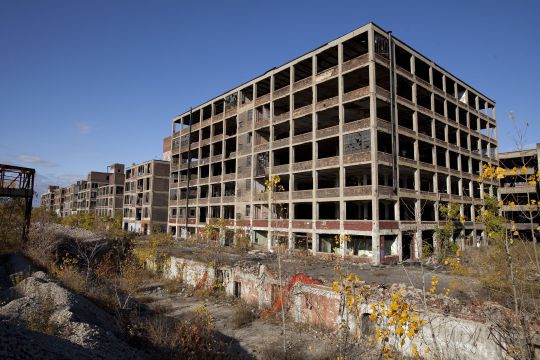
Abandoned Packard Auto Plant in Detroit. Photo by John Duce (CC BY-SA 3.0)
A few years ago, I woke up one day and read that the malls were dying. This news was shocking to me, despite the fact that I hadn’t been to a mall myself in years. Their sudden appearance and proliferation in the late 50s must have been seen as an equally surprising shock.
The purpose of Looking Around is to encourage people to take a critical look at the world they live in -- to appreciate its nuances, and take note of its changes. For those of us who pass by life at 45-80 miles per hour (often not by choice but rather necessity), it’s easy for these changes to blur into the fabric of endlessly horizontal scenery. For those of us in the cities, the news of the vacating office park surprises us, because we tend to believe that the edges - the burbs - are forever. Without taking a second to notice the day-to-day changes, one day we’ll wake up, flip on the news, and the whole world will suddenly be vertical again.
If you like this post, and want to see more like it, consider supporting me on Patreon! Also JUST A HEADS UP - I’ve started posting a GOOD HOUSE built since 1980 from the area where I picked this week’s McMansion as bonus content on Patreon!
Not into small donations and sick bonus content? Check out the McMansion Hell Store ! 100% of the proceeds from the McMansion Hell store will go to help victims of Hurricanes Harvey & Irma
Copyright Disclaimer: All photographs are used in this post under fair use for the purposes of education, satire, and parody, consistent with 17 USC §107. Manipulated photos are considered derivative work and are Copyright © 2017 McMansion Hell. Please email [email protected] before using these images on another site. (am v chill about this)
#architecture#urbanism#history#vernacular architecture#architectural history#suburbs#suburbia#20th century#american history
1K notes
·
View notes
Text
Discover why having an estate plan is crucial for securing your assets and ensuring your wishes are fulfilled. Learn more now.
#landlord tenant attorney Illinois#landlord-tenant dispute lawyer in Illinois#Illinois tenant lawyer#child abuse lawyer in Illinois#child custody attorney in Illinois#child support lawyer in Illinois#real estate eviction lawyer#illinois probate lawyers#probate attorney Chicago IL
0 notes
Text
Racial Justice and Civil Liberties: An Inseparable History at the ACLU
After World War I, it quickly became clear that the war to make the world “safe for democracy” had not made America safe for equality. Anti-Black race riots ripped through Chicago, New York, Washington D.C., and even Elaine, Arkansas. In October 1919, after Black sharecroppers in Elaine convened a union meeting, newspapers labeled the effort a “Negro uprising.” The state mobilized troops and mobs to quell the rebellion. The result was “possibly the bloodiest racial conflict in the history of the United States,” concluded the Encyclopedia of Arkansas History & Culture.
The American Civil Liberties Union’s origin story is tied inextricably to the xenophobic Palmer Raids, but the lesser-known events in Elaine, Arkansas were also formative. Racial violence was an unavoidable issue for any organization dedicated to the rights and liberties of everyone. Ten years earlier, the NAACP had been established to advance justice in the wake of the Springfield, Illinois race riot. During its first summer, the ACLU denounced the lynching of three Black men in Duluth, Minnesota who had allegedly raped a 17-year-old white girl. ACLU co-director Albert DeSilver wrote to Minnesota’s governor volunteering assistance in “the preservation of civil liberty.”
Weeks later, Minnesota Gov. Joseph A. A. Burnquist informed DeSilver that several men had been arrested in connection with the lynching. He did not tell DeSilver that none was convicted of anything serious.
Investigators realized, almost immediately, that the girl had not been raped. Nonetheless, the state tried seven Black men accused of participating in the fabricated crime. One was convicted and sentenced to hard time. That perversion of justice was not corrected until a century later when Minnesota granted the innocent man the first posthumous pardon in the state’s history.
Much of the ACLU’s early race-related work was similarly futile: highlighting racial atrocities America refused to stop. In 1921, the ACLU published three provocative pamphlets. The most innovative was “Debt-Slavery” by William Pickens, a sociologist and field secretary for the NAACP. Pickens argued that America had replaced chattel slavery with economic bondage and employed lynching as a form of enforcement. He saw the Elaine massacre as a defense of the “debt slave system.”
The second pamphlet focused on the reemergence of the Ku Klux Klan. The third, “The Fight for Free Speech,” warned that reactionary forces were ascendant and observed that Negroes, foreign-born groups, and tenant farmers were “conscious of the condition but incapable of outspoken resistance.”
Back then, the ACLU supported racial justice but was not at the forefront of the fight, generally deferring to the NAACP. But it assiduously documented anti-Black violence and states’ restrictions on “Negroes’ rights.” In 1929, founding executive director Roger Baldwin suggested a radical expansion of the ACLU’s role, proposing that the organization work more vigorously on behalf of “Negroes in their fight for civil rights.” Additionally, Baldwin established a seat on the board for the NAACP recognizing the special relationship with the organization on civil rights cases and invited James Weldon Johnson to serve at the founding of the ACLU.
Documenting Discrimination
In 1931, the ACLU issued “Black Justice,” a groundbreaking study on discrimination. The report slammed laws and policies that forced Black people to attend segregated schools, barred their admission to “white” hospitals, and denied Black people a fair wage, trial by their peers, the right to vote, or the right to marry outside the race.
NAACP executive secretary Walter White called the publication “excellent publicity” for the NAACP’s work. Baldwin also provided direct financial support to the NAACP through a foundation set up by Charles Garland, a young Harvard dropout who inherited a fortune he pledged to spend for “the benefit of poor as much as rich, of Black as much as white.” Baldwin served as the foundation’s secretary and its grants largely reflected his priorities.

NAACP Secretary Walter White.
(Credit: Library of Congress)
In 1931, the ACLU took on the Scottsboro Boys case, which centered on nine Black youths charged with raping two white women on a freight train in Alabama. The suspects, after being pulled from the train, were rushed to trial in less than two weeks. The first two convictions came on the second day of trial. Two days later, eight of the nine stood convicted and sentenced to death. Jurors deadlocked on the fate of the ninth defendant, who was only 14.
The ACLU dispatched Hollace Ransdell, a Columbia-educated journalist, to investigate. Ransdell produced a detailed and influential report that made it clear the two women had made up the sexual assault story.
The boys’ lawyers appealed to the state supreme court, which refused to overturn all but one conviction. Meanwhile, the NAACP and the Communist-backed International Labor Defense fought over which entity would represent the boys. Eventually, the lawyers came together and appealed to the Supreme Court, with longtime ACLU attorney Walter Pollak arguing the case. The court sided with Pollak, agreeing that the state, in denying the defendants their choice of counsel, had violated their right to due process.
Alabama shrugged off that and every other reversal, including two more landmark Supreme Court decisions that overturned the convictions because of the exclusion of Black jurors. Finally, in 1937, the Alabama prosecutor exonerated three of the defendants, releasing two others because they were juveniles at the time of the alleged crime. The others eventually found their way out of prison, their lives shattered because Alabama refused to admit that whites had lied about Blacks.

In this July 26, 1937 file photo, police escort two of the five recently freed “Scottsboro Boys,” Olen Montgomery, wearing glasses, third left, and Eugene Williams, wearing suspenders, fourth left, through the crowd greeting them upon their arrival at Penn Station in New York.
(Credit: AP Photo/File)
A Convening of Allies
World War II provided yet another occasion for America, and the ACLU, to reflect on racial prejudice. The ACLU’s major wartime anti-racism effort was the Committee on Racial Discrimination in the War Effort. Convened in early 1942, the committee was chaired by author Pearl Buck, who envisioned involving “all existing white or mostly white organizations” in a movement that would end discrimination not just in government, but in housing, wages, trade unions, and throughout society.
Winifred Raushenbush, a freelance writer hired as executive secretary, authored a widely praised pamphlet titled How to Prevent a Race Riot in Your Home Town. In “every war period the danger of race riots in great,” observed Raushenbush, who suggested that with a little planning, foresight, and good will, riots could be avoided.
The committee never achieved Buck’s ambitious goals, but it garnered a lot of attention. And it brought together some 30-plus organizations — including Alpha Kappa Alpha, the American Jewish Committee, the YWCA, and the National Lawyers Guild — to ruminate on race.
Japanese Incarceration and Internal Disagreement
Following the Pearl Harbor attack, America’s military classified Japanese Americans as a security threat. Under an executive order signed by President Roosevelt, some 115,000 Japanese American residents (most of whom were U.S. citizens) were targeted for relocation from a designated exclusion zone along the West Coast.
Baldwin wrote a public letter to the president addressing the “unprecedented” order that authorized the exclusion zone, calling it “open to grave question on the constitutional grounds of depriving American citizens of their liberty and use of their property without due process of law.” But the organization’s board was split on the order, with a large segment of Roosevelt loyalists reluctant to criticize the war effort. The organization ultimately adopted a resolution acknowledging the government’s constitutional right “to remove persons … when their presence may endanger national security.”

Japanese-Americans transferring from train to bus at Lone Pine, California, bound for war relocation authority center at Manzanar, April, 1942.
(credit: Library of Congress)
That resolution left the ACLU’s lawyers in a bind, as it was difficult to argue the internment policy was legally wrong but also constitutionally permitted. Despite the legal handcuffs it had manufactured for itself, and following internal debate, the ACLU ultimately mounted a series of challenges to Japanese internment. On June 21, 1943, the Supreme Court decided in Hirabayashi v. United States that the evacuation order was legal. That same day the court also decided in Minoru Yasui v. United States that the military-imposed curfew was a legitimate response to the harms threatened by the war.
Two other cases were not decided until after the War Department had concluded that internment was no longer a military necessity. In December 1944, the Supreme Court decided the government had no right to detain loyal citizens. It also found that ACLU client Fred Korematsu, in defying the exclusion order, had broken the law. It wasn’t until the 1980s that Korematsu’s conviction was vacated, and President Ronald Reagan signed the Civil Liberties Act, issuing a formal government apology and granting monetary reparations to surviving Japanese Americans incarcerated during World War II.
Seeking Justice in the South
In September 1963, four Black girls were killed while attending church in Alabama when a bomb planted by the Ku Klux Klan exploded. The following morning, local lawyer Charles Morgan delivered a fiery speech that attracted national attention: “Every person in this community who has in any way contributed during the past several years to the popularity of hatred is at least as guilty, or more so, than the demented fool who threw that bomb.”
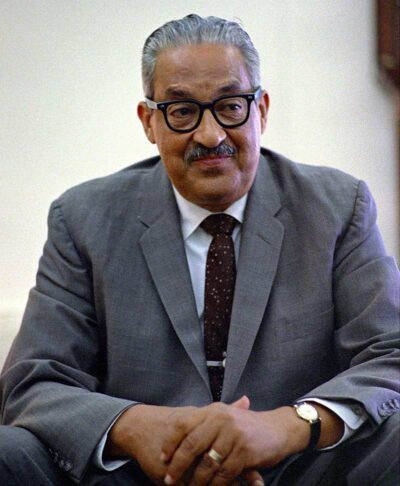
Thurgood Marshall, seen here in the White House in June 1967, the year he was appointed to the U.S. Supreme Court.
(Yoichi Okamoto/National Archives and Records Administration)
Two decades earlier, in 1940, Thurgood Marshall created the NAACP Legal Defense Fund. Marshall, who served on the ACLU’s board from 1938 to 1946, was the architect of a brilliant legal strategy to dismantle segregation. The ACLU submitted amicus briefs for some of the LDF cases during this period including Brown v. Board of Education. By 1964, the ACLU approved a new regional office in Atlanta charged with overseeing the growing array of initiatives attacking racial oppression in the South. Morgan was named director.
Working in partnership with other civil rights organizations, the office became deeply involved in virtually every major civil rights issue in the South: expanding voting rights; ending the exclusion of Black jurors; and eliminating racially motivated sentencing disparities. The ACLU also fought prohibitions against interracial marriage, which the Supreme Court struck down in 1967 in the landmark case, Loving v. Virginia.
As the ACLU plunged into these civil rights battles, it also pushed the Warren court into rethinking criminal justice, advocating for reforms that reverberate today. That process began with the case of Clarence Earl Gideon, a drifter charged with burgling a pool hall in Florida who the Supreme Court decided was entitled to representation at public expense. Although the ACLU was not directly involved in that case, it was a driving force in those that followed. Escobedo v. Illinois (1964) revolved around Danny Escobedo, who was suspected of killing his brother-in-law. Escobedo was not informed he had a right to retain a lawyer or to remain silent, and made incriminating statements that led to his conviction. The ACLU argued his case before the Supreme Court, which concluded that Escobedo’s rights had been violated.
Gideon was the prelude to Miranda v. Arizona, in 1966. Ernesto Miranda was accused of kidnapping and raping an 18-year-old woman; he confessed without being informed of his right to remain silent. The ACLU argued that Miranda’s treatment violated his Fifth Amendment right against self-incrimination. The Supreme Court agreed, and Miranda rights were born.
At the time, those cases were not considered part of a racial justice agenda, but as the racial inequities in America’s criminal justice system became clearer, the ACLU came to view its criminal justice work in a new light.

Ira Glasser (at left in beige suit) marching in Atlanta, GA, with Coretta Scott King (center) and others in 1997 Martin Luther King, Jr. Day parade.
(Credit: photographer unknown, Studio III: 1021 Northside Drive, Atlanta, GA 30318; 404-875-0161)
Ira Glasser believes the ACLU’s deepening involvement in racial issues was inevitable. Glasser joined the New York Civil Liberties Union in 1967 and became its director in 1970. Eight years later he succeeded Aryeh Neier as executive director of the national ACLU, and quickly found himself immersed in issues of race. The Voting Rights Act, signed by President Lyndon Johnson in 1965 to combat discrimination against Black voters in the South, was scheduled to expire in 1982. President Reagan opposed its extension. The ACLU became a leader in the fight to preserve the law, eventually winning passage of a new bill which Reagan signed.
As Glasser reflected on the ACLU’s myriad issues, he “began to see who was affected by these violations of civil liberties and this explosive growth of incarceration, and who was arrested, and who was prosecuted, and who was searched … They were all Brown and Black.” Glasser came to see the Nixon administration’s drug war as “a successor system to slavery, continuing and expanding skin color subjugation.”
Those insights helped to broaden the organization’s racial justice agenda, leading to an increased focus on issues such as racial profiling and stop and frisk. In the late 1990’s, Michelle Alexander, who was at the time Director of the Racial Justice Project at the ACLU of Northern California, instigated a national campaign titled “Driving While Black or Brown” which revealed discriminatory policing practices and led to the introduction of legislation in 44 states to stop them.

Civil Liberties Are Civil Rights
In 2006, the ACLU formalized its investment in the fight against racial inequality by creating a national Racial Justice Program. Anthony Romero, a Puerto Rican native of the Bronx and the ACLU’s first executive director of color, believed, like Glasser, that race was inextricably intertwined with other ACLU concerns. Dennis Parker, a Harvard Law graduate who had worked for the NAACP Legal Defense and Educational Fund, became the program’s first director. Parker noted that race was woven throughout the organization’s many issue areas: “Race really informs … every area that the ACLU works [in]: women’s rights, disability, or voting.”
Parker knew working for the ACLU would be different from working for an organization with racial justice as its paramount mission: “At LDF … we were advocating on behalf of Black people. There may have been questions about what would be best … but it was not a question of should we be representing the Klan.”
Parker’s observation touched on a reality that has bedeviled the ACLU from the beginning: the occasional friction between its commitment to racial justice and also to free expression. The issue was vexing enough in the 1930’s that the ACLU released a pamphlet titled “Shall We Defend Free Speech for Nazis in America?” The organization concluded that the best defense of one group’s right to speak was a defense of all groups’ rights.
When the ACLU was attacked in 1978 for defending Nazis intent on marching on Skokie, a Chicago suburb that housed Holocaust survivors, the answer was much the same. David Goldberger, the young Jewish lawyer leading the case, pointed out that policies Skokie employed against Nazis could also be used against Jewish war veterans. The power to shut down speech, Goldberger argued, was too important to be left to local officials: “Think of such power in the hands of a racist sheriff.”

ACLU legal director David Goldberger, left, appears at a Chicago Press conference with ACLU Executive Director David M. Hamlin. Both men were happy with the court’s decision to allow Frank Collin and his Nazi group to hold a rally in Chicago’s Marquette Park.
(AP)
That view became so entrenched that in 2017, the ACLU represented a white supremacist group determined to hold a rally in Charlottesville. After the event resulted in a young woman’s death, friends of the ACLU second guessed the organization’s decision, and rigorous internal conversations about the choice to defend racists took place. The conversations resulted in case selection guidelines to assist ACLU staff in weighing the competing interests that may arise when work to protect speech may raise tensions with racial justice, reproductive freedom, or where the content of the speech conflicts with ACLU policies on those matters. The guidelines also suggest that the ACLU will generally not defend armed protest because of the chilling effect it can have on free speech.
In the ACLU’s 1920 birth announcement, the new organization swore to fight “all attempts to violate the right of free speech, free press, and peaceful assemblage.” That position was essentially unchanged when Roger Baldwin proposed his grand expansion. Baldwin did not foresee the possibility of that position conflicting with the defense of racial justice. Indeed, in an exchange with his biographer Peggy Lamson, Baldwin expressed frustration with Black ACLU board members who did not share his view.

ACLU Board member James Weldon Johnson, seen here in 1932.
James Weldon Johnson, in Baldwin’s view, “couldn’t see much beyond the use of civil liberties for the equality of Blacks.” As Baldwin saw it, Black board members’ commitment to racial equality blinded them to the larger picture. What the larger picture is, of course, depends on one’s perspective.
As eager as Baldwin was to expand the ACLU’s involvement in issues of race, he never saw that as the ACLU’s main battle, though it was still listed among the organization’s top priorities in its first annual report in 1920. He saw no need to balance the demands of racial justice with those of free speech. The modern ACLU has a more complicated view.
As Romero put it, “If I were the head of the Puerto Rican Legal Defense Fund, I wouldn’t bring a Nazi case. If I were the head of the First Amendment Center, I would bring every Nazi case and not worry about the racial justice implications. I think part of what is magical and different and kind of vexing is an organization that’s trying to accomplish both and say, ‘They’re both equally important to us.’”
That perspective suggests that an organization seriously devoted to both free speech and racial justice is obligated to tackle a question with no obvious answer: In a world where unrestrained speech is routinely weaponized to frustrate justice, what combination of rights, restraints and responsibilities moves the nation toward the most moral version of itself? The ACLU has come to see that civil rights and civil liberties are inextricable, and the protection of the latter is inherently tied to the long fight for racial justice.
from RSSMix.com Mix ID 8247012 https://www.aclu.org/news/civil-liberties/racial-justice-and-civil-liberties-an-inseparable-history-at-the-aclu via http://www.rssmix.com/
1 note
·
View note
Photo

Unlawful Evictions or Illegal Lock Outs in Chicago, Illinois
Evictions Are Serious Business For Both Sides landlord tenant lawyer in chicago. Illinois & Chicago Law Protects Tenants From “Self-Help, visit us now more.
0 notes
Photo
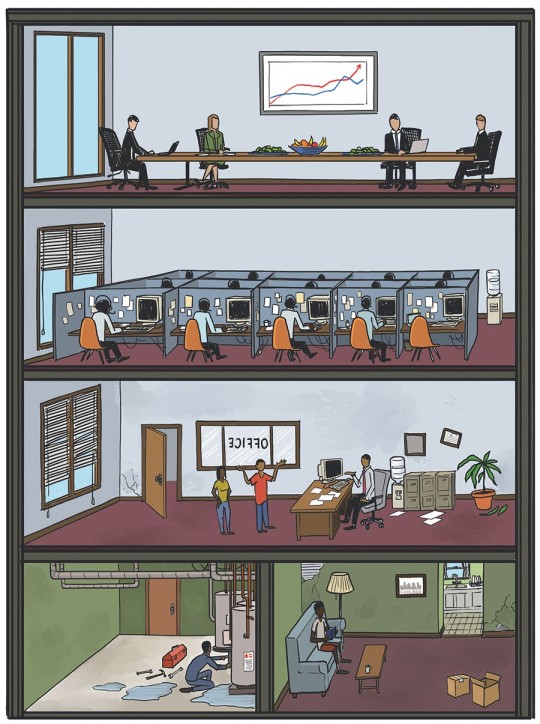
In September the Reader was alerted to two complaints, one filed with the city's Commission on Human Relations and the other with the Illinois Department of Human Rights, detailing discrimination and racist statements made by high-level managers at Pangea, one of Chicago's biggest corporate landlords. Until the start of the coronavirus pandemic, the company was the city's most prolific filer of eviction cases. Its apartment holdings are concentrated largely in Black neighborhoods on the south and west sides of the city and in nearby suburbs, now totaling 9,400 units in 492 buildings. The company also has several thousand more units in Indianapolis and Baltimore.
The complaints were filed by Armando Magana, 45, the chief maintenance supervisor at Pangea in Chicago who'd been with the company since 2010. He's worked in various roles and received promotions and bonuses, most recently in February, Magana writes. "Notwithstanding my exceptional performance, Pangea has repeatedly discriminated against me because of my Hispanic ethnicity and my Mexican national origin. Throughout my employment, Pangea has also subjected me to a hostile work environment based on numerous derisive and derogatory statements made by Pangea's managers and executives regarding my ethnicity and national origin."
Magana's complaint includes several examples of such statements from vice president of operations Derek Reich and CEO Pete Martay. He claims that in 2017 Reich "told me that I should avoid being seen working with an African-American work colleague if I did not want to be viewed in the same way as that 'lazy nigger.'"
Magana details two occasions in 2018 when Reich "suggested hiring 'illegals' because they will accept less compensation," and resisted Magana's recommendations for which employees should get raises, allegedly saying, "'aren't these guys illegal?'"
Further in the complaints he recounts a 2019 meeting in which management for a newly acquired building near Loyola University on the north side was allegedly discussed. "My African American colleague asked, 'who will be managing the building,' to which Mr. Reich responded, 'they've never seen a Regional Manager of your kind in that area.' I asked about getting access to the roof top, to which Mr. Martay stated, 'Yeah I can imagine Armando showing up with his trash can and saying "Hello I'm Armando, the janitor here to clean up after you."'"
Later that year, Magana alleges he "met with Mr. Reich at a property that Pangea had recently begun to manage. During a discussion regarding employee staff assignments, Mr. Reich remarked that 'Mexicans are for custodial and maintenance, Blacks for property management, and Whites for the back office, that's it.'" The following month Magana alleges that Martay said to him, in front of other employees, "I should make you pull your fucking tools back out and make you clean shit out of the fucking tubs, like you used to."
Magana writes that he reported Martay's "derogatory comments" to Reich and both supervisors' comments to Pangea's HR manager Lori Bysong as well as the company's CFO Patrick Borchard and cofounder and former CEO Steve Joung. "Mr. Joung listened to me, then responded by saying that he doubted workplace discrimination was occurring."
Magana claims in the complaint that at the end of 2019 he also had a conversation with Pangea's operations manager Sean McQuade about hiring and pay for new workers, requesting $22/hour for one of them. "Mr. McQuade responded by asking 'Do you know if he's illegal? Do you think he has papers? . . . Do you think this guy is worth $22/hour?'" Again, Magana claims he reported these comments to HR, Pangea's in-house attorney Jennifer Dean, and other supervisors.
"Despite having complained on multiple occasions directly to multiple members of Pangea management, no one at the Company ever responded to, investigated, or otherwise communicated with me regarding my several complaints," Magana writes. "Rather, Mr. Reich continues to make derogatory, discriminatory comments toward me. Specifically, on May 12, 2020, Mr. Reich called me and stated, 'stop treating me like a shine. Last time I checked I was white.'"
In both an internal e-mail obtained by the Reader and in an e-mailed statement from CEO Pete Martay, Pangea has denied Magana's allegations and said he's refused to cooperate in the company's internal efforts to investigate.
"Pangea Properties has zero tolerance for racist or discriminatory behavior," Martay wrote to the Reader. "We take allegations of this nature very seriously. As a result, we hired a neutral investigator to carry out a prompt and thorough investigation and have also engaged legal representation to defend the company against allegations we believe are baseless. The complainant and his witnesses have refused multiple requests to participate in our investigation."
The Reader also presented the company with an opportunity to respond to additional allegations made by ten other current and former employees about Pangea's corporate culture. These included vivid descriptions of demeaning statements by Reich and other supervisors, as well as allegations of segregated and demeaning working conditions. "We categorically deny the claims in the complaint and also the statements made against us by former employees," wrote Martay. Neither Reich nor McQuade, whose conduct Magana also referenced in his complaint, responded to a request for comment.
Hostile work environments are both ubiquitous and difficult to reform. Their toxicity can be hard to pin down and prove on paper, especially when corporate promotions and official praise are interspersed with interpersonal disrespect and disregard. As a reckoning over the prejudices endemic to white-dominated workplaces roils the private and public sectors, employees of color from businesses and institutions as varied as Adidas, LinkedIn, Vogue, the San Francisco health department, and Loyola University have begun speaking out about the racial microaggressions, gaslighting, and harassment that defines office culture for them.
Even as he received glowing performance reviews, Magana could also feel hostility from management. For example, in an August 2013 e-mail obtained by the Reader, Reich wrote a brief note to another regional manager. The subject line read, "Armando was excited about converting to Islam . . . " and inside the body of the e-mail the sentence ended " . . . Until he found out you can't eat pork." Attached was a photo of Magana, grinning, in a little white hat reminiscent of a kufi skull cap.
When asked about the e-mail Magana said he was dismayed at being the target of a crude joke that appeared to be both Islamophobic and about his weight. "I never thought he was gonna take a picture and send it," he said with a grim chuckle as we looked at the image over beers at the nearly deserted patio of the Promontory in Hyde Park. Magana wore a black valve mask and a short sleeve blue polo, apparently unbothered by the biting gusts of wind on that late September afternoon. As he stared at the photo he said the fact that it had been e-mailed was unusual; in his experience Reich rarely left a paper trail of demeaning comments. "It was always phone calls with Derek," Magana said. "He really doesn't like to put anything in e-mail. If you send him an e-mail, he'll call. If you meet him in the field, he'll make those comments."
As documented in his complaints, Magana attempted to have the "discriminatory communications and behavior" he experienced addressed internally, but complaints to HR and leaders of the company didn't help. Finally he started working with attorney Marc Siegel to appeal to external authorities to intervene. The company soon also hired an outside attorney to help handle the situation.
Pangea's lawyers "kept telling [Siegel] that I was exaggerating and they always treated me good and they weren't being racist toward me," Magana told the Reader. "Long story short, I told my attorney I'm not gonna play this game, I'm gonna file this with the state and city and I'm gonna make it public."
By late spring the stress of working at Pangea had intensified due to the coronavirus pandemic. "I broke down because when the COVID started Derek was just calling me every other day, every other day: 'What are you doing?' I'd say 'We're working . . . but we don't have any sanitizing supplies. We don't have masks.'"
Magana said Pangea didn't offer hazard pay. Some field employees took time off because they were scared to go back into the apartment buildings, especially when word got around that tenants were falling ill. Magana says Reich didn't seem to care. "It was like, 'All these guys need to come back to work.' I'm like, 'Derek we're all working, there's some people who took off because they're scared.'"
Magana said that Reich demanded that he choose five of his staff to fire as part of a company effort to reduce the employee headcount to below 500 so that Pangea could qualify for a Paycheck Protection Program loan from the federal government.
He said that in late March Reich called him. "He says, 'You got any shitty people working for you? Give me five.' I'm like, 'I don't have any shitty people working for me.' He's like, 'Well, give me five.'"
The Reader obtained an e-mail Magana sent to Reich the next day, listing four employees who changed positions in the company without being replaced and one who was about to leave Pangea anyway. "There's your four plus one, he's already out the door," Magana recalled thinking. He said that after that he got another phone call from Reich who demanded he name five additional people to fire because Pangea's employee count was at 512.
Magana said he submitted another list of names. "I was destroyed about that," he said. According to records released by the Small Business Administration in July, Pangea was awarded a $5-$10 million loan through the PPP program. They listed an employee count of 494.
By June, Magana needed a break. The stress of the job was getting to him and affecting his family, and he took a leave of absence for a month and a half. "I got kind of depressed, stressed out, I was trying to take care of my health," he said. "I found out my son was depressed, so I had to dedicate myself to him."
Magana said things got worse for him at Pangea after he came back to work in July. There were sudden extra meetings where he was questioned about his work. He felt increasingly micromanaged.
Nevertheless, Magana was still determined to continue working at the company, where he was making $115,000 in salary, got bonuses, and to which he'd devoted a decade of his life. "I'm happy where I'm at, I'm good at what I do, I've done nothing wrong," he said.
Word about Magana's complaint began to get out at Pangea, and e-mails from pseudonymised accounts suddenly appeared in all field employees' inboxes, sharing Magana's complaints and encouraging them to file their own. The company quickly deleted these e-mails from employees' inboxes, however. In a September 30 e-mail to all field employees obtained by the Reader, Martay acknowledged that deletion, adding that the "current employee" who complained about mistreatment "refused to cooperate and will not speak to the independent investigator" Pangea hired to look into the allegations. Though Martay didn't refer to Magana by name in this e-mail, Magana says he felt the CEO's message was meant to undermine him. "We categorically deny the claims made in the complaint and have engaged legal representation to defend the company against them," Martay wrote.
By the beginning of October, Magana felt he could no longer remain at Pangea. "I cannot continue to work under hostile environment with retaliation," he wrote to me in a text message. Though he technically resigned from his job himself, his attorney argues that he was "constructively discharged" by management because of the "discrimination and harassment and retaliation he faced at work."
According to legal precedent established by the U.S. Supreme Court in the 2006 Burlington Northern & Santa Fe Railway Co. v. White decision, the definition of retaliation for complaints about workplace discrimination is broad. "It could be making your work life more difficult. It could be micromanaging you. It could be icing you out—anything that could make a reasonable person feel dissuaded from bringing a complaint," said Siegel. "It doesn't have to be a termination or written suspension."
0 notes
Photo

Michelle Obama
- Michelle is a lawyer and writer who was previously First Lady of the United States, married to Barack Obama
- She was the first African-American First Lady in US history
- She was raised on the South Side of Chicago, Illinois
- Her father suffered from multiple sclerosis
- Michelle joined a gifted class at Bryn Mawr Elementary School by the sixth grade
- She attended Whitney Young High School, Chicago's first magnet high school, established as a selective enrollment school, where she used her fear of how others would perceive her as motivation to succeed
- She experienced gender discrimination growing up despite her achievements
- Michelle was on the honor roll for four years, took advanced placement classes, was a member of the National Honor Society, and served as student council treasurer; she graduated in 1981 as the salutatorian of her class
- She is a graduate of both Princeton University and Harvard Law School
- At Princeton, her white roommate’s mother (unsuccessfully) tried to have her daughter moved because of Michelle’s race; she said that it was during this time that she became more aware of ethnicity, class, and racial divisions
- She also got involved with Princeton’s Third World Center, an academic and cultural group that supported minority students, running their day care center, which included after school tutoring as well; she challenged the teaching methodology for French because she felt that it should be more conversational; she wrote a thesis titled Princeton-Educated Blacks and the Black Community as part of her graduation requirements
- In July 2008, she accepted the invitation to become an honorary member of the 100-year-old black sorority Alpha Kappa Alpha, which had no active undergraduate chapter at Princeton when she attended
- At Harvard, Michelle participated in demonstrations advocating the hiring of professors who were minorities, and worked for the Harvard Legal Aid Bureau, assisting low-income tenants with housing cases
- She is the third First Lady with a postgraduate degree
- Following law school, she was an associate at the Chicago office of the law firm Sidley & Austin, working on marketing and intellectual property; she continues to hold her law license, but as she no longer needs it for her work, it has been on a voluntary inactive status since 1993
- In 1991, she held public sector positions in the Chicago city government as an Assistant to the Mayor, and as Assistant Commissioner of Planning and Development
- She became Executive Director for the Chicago office of Public Allies, a non-profit organization encouraging young people to work on social issues in nonprofit groups and government agencies, in 1993; she worked there nearly four years and set fundraising records for the organization that still stood 12 years after she left
- Michelle also worked as the Associate Dean of Student Services at the University of Chicago, where she developed its Community Service Center, and as the Vice President for Community and External Affairs at the University of Chicago Medical Center
- She campaigned actively during her husband’s presidential runs, delivering speeches at the 2008 and 2012 Democratic National Conventions; she returned again to the DNC in 2016 to speak on behalf of presidential candidate and fellow First Lady Hillary Clinton
- During his campaigns, she also spoke openly about race, education, and motherhood
- As First Lady, Michelle became a role model for women, in addition to an advocate for poverty awareness and nutrition
- She also became a fashion icon
- During her early months as First Lady, she visited homeless shelters and soup kitchens, in addition to sending representatives to schools and advocating public service
- She hosted a White House reception for women's rights advocates in celebration of the enactment of the Lilly Ledbetter Fair Pay Act of 2009 Pay equity law
- In 2006, Essence listed her among "25 of the World's Most Inspiring Women”
- Vanity Fair listed her among "10 of the World's Best Dressed People” in 2007
- In 2009, Michelle was named Barbara Walters's Most Fascinating Person of the year
- She advocated on behalf of military families, helped working women balance career and family, encouraged national service, and promoted the arts and arts education
- She was an honorary guest at Oprah Winfrey's Legends Ball as a "young'un" paying tribute to the “Legends” who helped pave the way for African-American women
- In 2010, she took her first solo visit to a nation and traveled to Mexico to speak to young students, encouraging them to take responsibility for their futures; she is a believer in success coming from unlikely places, and not discrediting underprivileged people
- She was actively involved in community events in foreign countries, and it was said that she advanced her husband’s foreign policy and relations
- Among many things, she has been known for wearing clothes by African designers such as Mimi Plange, Duro Olowu, Maki Oh, and Osei Duro, and styles such as the Adire fabric
- In 2012, Michelle and her husband were awarded the Jerald Washington Memorial Founders' Award by the National Coalition for Homeless Veterans (NCHV), which is the highest honor given to homeless veteran advocates; she was awarded it again alongside Jill Biden in 2015
- She joined the campaign to bring back school girls who had been kidnapped in Nigeria in 2014, utilizing the campaign hashtag #bringbackourgirls
- She extended organic efforts in the White House by planting the White House Kitchen Garden, the first White House vegetable garden since Eleanor Roosevelt served as First Lady; she also installed bee hives on the South Lawn of the White House; the garden supplied organic produce and honey to the First Family and for state dinners and other official gatherings
- She created and took charge of the administration-wide initiative Let’s Move! to reverse progress in the child obesity trend
- Michelle has consistently been an open advocate for LGBT rights, opposing constitutional amendments banning same-sex marriage and promoting equality for everyone
- In 2017, during an appearance at the Partnership for a Healthier America conference, she rebuked the Trump administration for its delay of a federal requirement designed to increase the nutritional standards for school lunches
- Also this year, she called for tech companies to add women for the diversifying of their ranks while attending the WWDC in Silicon Valley, California; she honored Eunice Shriver at the 2017 ESPY Awards; she delivered an address at the tech conference in Utah charging the Trump administration with having a fearful White House; she appeared in a video for the Global Citizens Festival advocating more attention to giving young girls an education; she attended the Inbound 2017 conference in Boston; she cited a lack of diversity in politics with contributing to lawmakers being distrusted by other groups at the Philadelphia Conference for Women; she discussed gender disparity in attitudes with Elizabeth Alexander while at the Obama Foundation Summit in Chicago; and she spoke at the Bushnell Center for the Performing Arts in Hartford, Connecticut
20 notes
·
View notes
Text
THE EFFECTIVE CHICAGO REAL ESTATE ATTORNEY FOR LEGAL LIABILITIES
Going into a real estate contract can come with unforeseen liabilities that may not be immediately apparent.
That’s why you need to hire a Chicago real estate lawyer to look over an agreement before you decide to sign it.
You want to make sure that all the details are set in place, and the responsibilities and obligations of everyone involved should be clearly spelled out.
Many things can happen when you go into a business agreement, and real estate contracts are no exception. Someone may refuse to pay, or he or she may decide to back out at the last minute. If you don’t prepare yourself for these scenarios, you may be faced with disappointment or regret. Not to mention, it can affect your future, especially when you have high expectations.
You want to do whatever you can to protect yourself from any legal liabilities that may come down the road, especially when it involves a place in which you may be living. A Chicago real estate lawyer can help you to offset these risks, as he or she will understand the finer points of Illinois Real Estate Law.
A Chicago real estate attorney will not only make sure you are treated fairly by others who are involved, but he or she will be able to work on your behalf if a dispute should arise.
Chicago Real Estate Law Firm is one the leading Chicago real estate firm and we have a team of some of the best real estate lawyer in Illinois, who will fight for you and your financial future.
We pride ourselves in offering quality service to our clients, and we work hard to serve their interests. With real estate attorney by your side, you can buy and sell real estate with the peace of mind that you deserve, and you will have the protection you need from any legal liabilities that may come down the road.
A contract is a legally binding agreement, and this applies to all real estate contracts. This includes:
Purchase agreements (when buying or selling a property)
Short sales
Rental agreements
Commercial real estate agreements
Land development and construction agreements
Every one of these contracts may come with their own set of challenges, and you should be prepared to deal with any disputes or disagreements that may arise. Every detail needs to be spelled out, which includes any money that is paid or received. It also includes the stipulations of entering or exiting the contract.
A Chicago real estate attorney will be able to look over the contract and make sure that everything is in accordance with Illinois Real Estate Law.
This person will be your best defense in eliminating any legal liabilities that may come down the road.
ChicagoRealEstateLawFirm.com is a qualified Chicago real estate attorney that can help you with any legal matters related to Illinois Real Estate Law.
Feeling drastic about your increasing property tax bills or if your tenant has become a challenge for you? We the Chicago Real Estate Law Firm are used to deal with such things on a daily basis. Here in Chicago and its surrounding areas – our services are giving a new life to property owners. Please contact us now, and we are ready to answer all of your real estate related queries!
This post originally appeared at https://www.chicagorealestatelawfirm.com/
1 note
·
View note